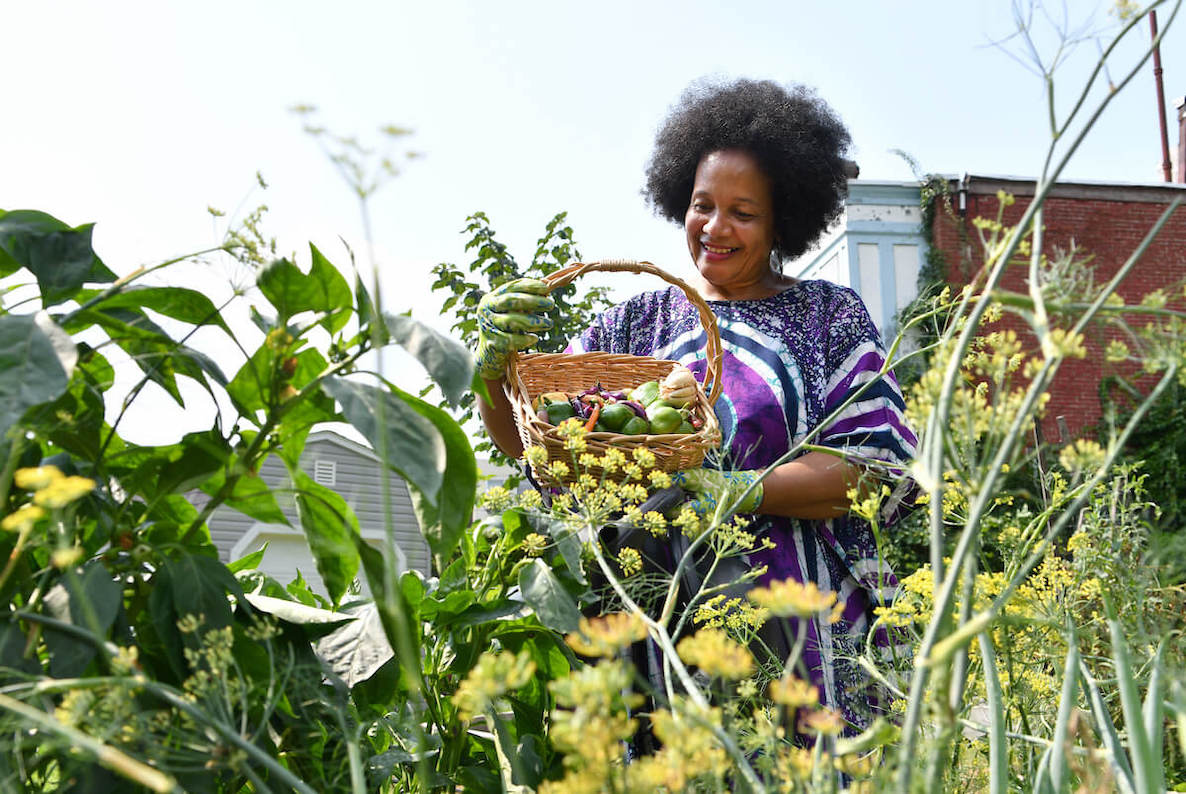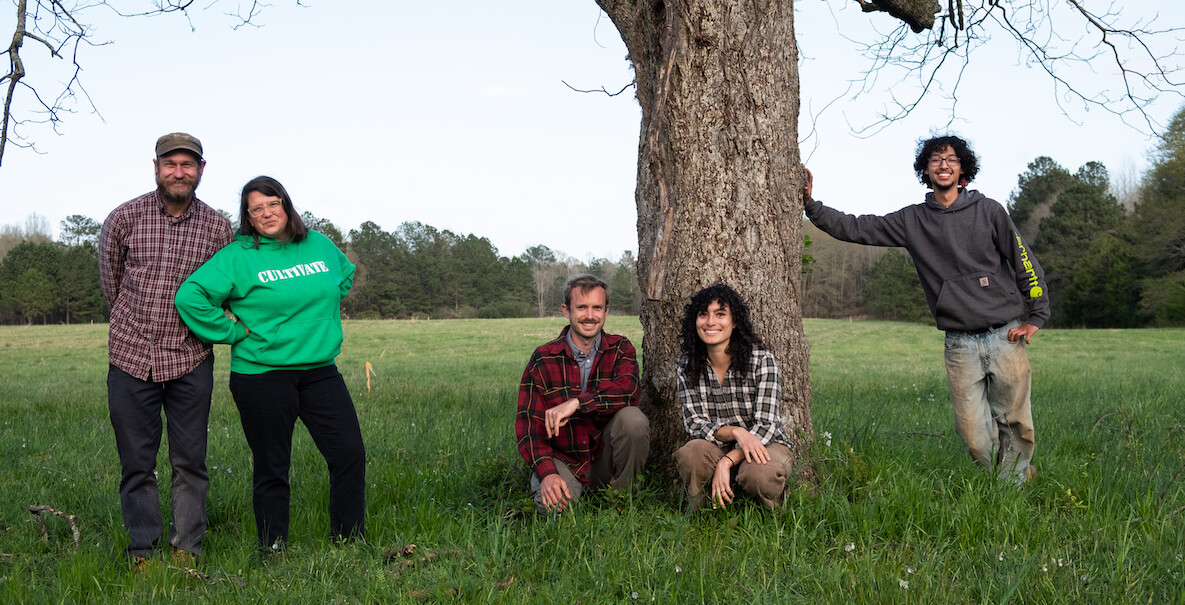It was the soil that sold them.
In the fall of 2020, five long-time farmers toured a 43-acre plot of land near Atlanta, Georgia, looking for a home for their new cooperative organic vegetable farm, Love is Love Cooperative Farm. They surveyed the overgrown field, dug their heels in the soil, knelt down in the tall grass to feel it with their fingers.
A few weeks later, two of the farmer-owners, Monica Ponce and Demetrius Milling, returned with their soil probe—a hollow metal cylinder about ¾ inches in diameter and two feet long used to gather a soil sample. “At one point, it went down all the way down to pretty much the handles of the soil probe,” remembers Ponce excitedly. “Like 22 inches.” It was a clear sign that the soil was loose, rather than compacted—ideal for healthy root growth—and they could see about 10 inches of good organic matter.
“As far as like Georgia clay goes, it’s pretty loamy, crumbly, sandy stuff,” says Ponce, “It’s beautiful.”
The land was just land—no barns or greenhouses on site. The Love is Love team knew it would be expensive to build the infrastructure themselves; but the investment would be worth it since—unlike most first-generation farmers—these farmers knew they would be on this land for the long haul.
“I think we set up this kind of false dichotomy like, You have to be a 10,000 acre farm to feed the world,” says Funderburke. “The reality is—and the pandemic only reinforced this—a more local food system anchored in closer proximity to the city is much safer in times of shocks.”
That’s because Love is Love Cooperative Farm is part of the Working Farms Fund, a program the Conservation Fund launched in greater Atlanta last year to give small and midsize farms an easier path to land ownership.
It works like this: Vetted farmers work with the fund’s team to find available land for their operation; the Conservation Fund purchases the land and leases it to the growers while they secure conservation easements to preserve it from future development. The value of the land subsequently drops significantly—often by about half—and the farmers have the opportunity to purchase it themselves.
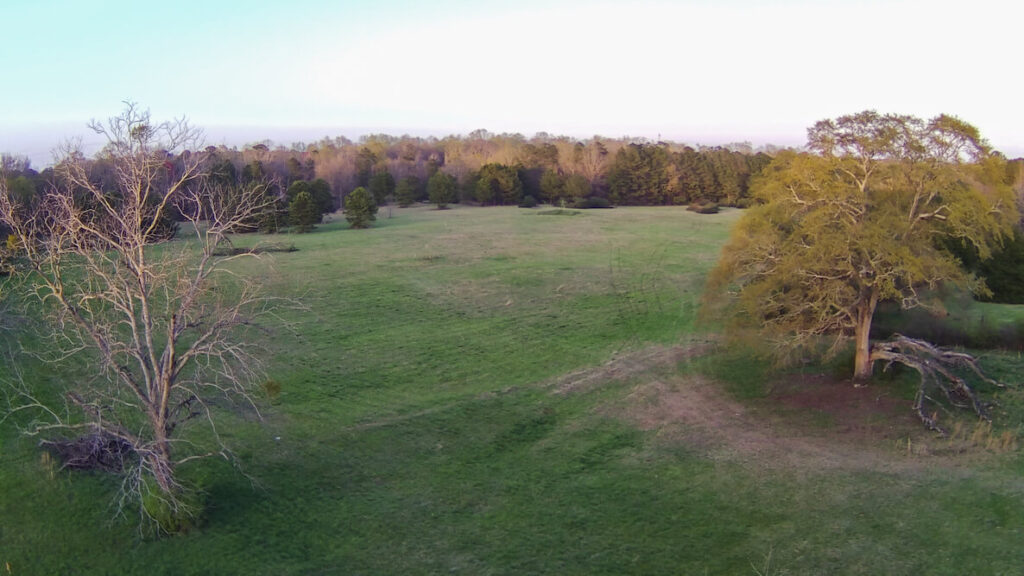
The program also affords the farmers the opportunity to sell their products to institutions like Emory, which, between the university and 14 hospitals, is the largest employer in metro Atlanta. That allows the farms to scale up.
The goal is to help experienced farmers who historically haven’t had access to land grow their businesses, knowing that they’ll be able to reap the benefits of the investments they’ll be making into the property long-term, and to make locally grown healthful foods more widely available and affordable.
In the first year, the Working Farms Fund deployed $3.3 million to match four farms—totaling 25 farmers—with 355 acres of farmland. “That was all land at risk of being lost, but is now on a pathway to permanent protection,” says Stacy Funderburke, the Conservation Fund’s Regional Counsel & Georgia and Alabama Associate State Director.
The farms range in size from 20 to nearly 200 acres, including a cattle farm, a cooperatively-owned organic vegetable farm and a collective of mostly Southeast Asian and West African refugee farmers called Global Growers Network. And Stacy says they’ve already got the next 20 farm businesses in the pipeline for this year.
The program is launching in Chicago early this year, and hopefully more major U.S. cities—though not Philadelphia yet—after that. “To start to anchor and revitalize these small to midsize farms that are in close proximity to where the demand is and where consumers are,” says Funderburke, “I think there’s huge opportunity.”
Reversing the trend of dwindling farmland
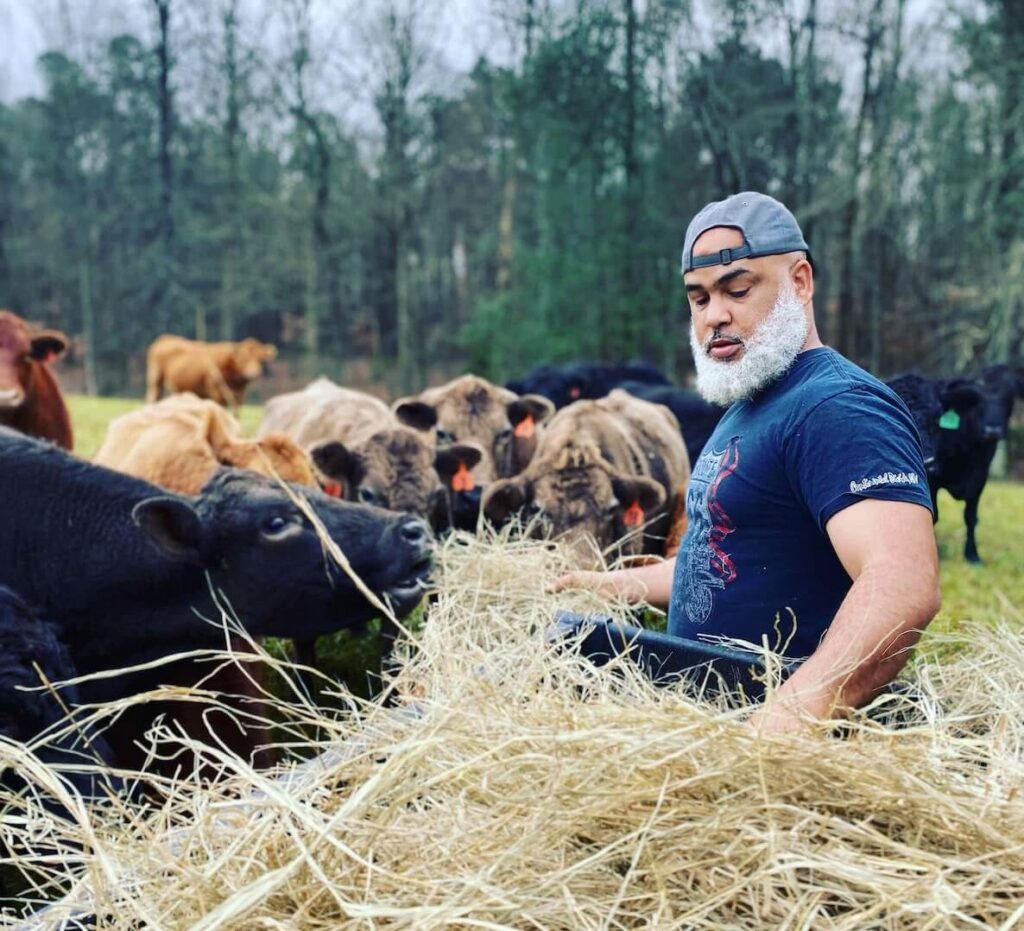
According to a 2018 report by the American Farmland Trust, between 2001 and 2016, 11 million acres of farmland and ranchland across the U.S. were lost to development. That’s about the same amount of land on which we grew all of our country’s fruit, nuts and vegetables in 2017. Or like 2,000 acres a day being paved over for 15 years straight. Much of that loss is concentrated around large metro areas, where sprawl continues to be relentless.
As our population grows and climate change continues to create more challenging farming conditions, we risk massive food shortages if we can’t maintain enough productive, versatile and resilient land.
Which is part of the Conservation Fund’s mission. Since 1985, the organization, headquartered in Arlington, VA, has protected about 8.5 million acres around the country—3 million of which have been working ranches, farms and forests.
“The idea is that if they don’t remain working and economically viable for the communities where they are, they’ll become something else—likely fragmented and developed,” says Funderburke. “And this reality is playing out around the country.”
RELATED: Judy Wicks’ new project unites rural and urban Pennsylvanians to strengthen communities
At the same time, according to USDA data from 2017, 95.4 percent of farmers in the U.S. are White; 64 percent are men. As recently as 2014, White people owned 98 percent of all farmland in the country. And on top of that, the average age of the American farmer is 59 and goes up every year.
“But despite those two trends, which are really difficult for agriculture, the flip side of that is that there are real opportunities,” says Funderburke. Demand for fresh food grown by local farmers who take good care of the land is still increasing. And there is a next generation of skilled, passionate and more diverse farmers—most who are not carrying on the family business or inheriting land.
“I learned that in direct communication with a lot of these farmers,” says Funderburke. “I realized that a lot of what the Conservation Fund does in our day to day is figuring out the land piece.” Combining that need for land near urban areas with the Conservation Fund’s work to preserve open spaces resulted in the Working Farms Fund.
Every grower who joins the program has an option to purchase their farmland embedded in their lease—when they’re ready, and when the farm has been protected, within five years. In the meantime, the Working Farms Fund, with funding from donors, foundations, USDA grants and the Conservation Fund (which has set aside $2 million for the program), works to secure a conservation easement that restricts future development and requires that the land preserve certain public benefits.
In the greater Atlanta area, that easement significantly reduces the cost of the property, often by about half. And when the farmer does purchase, that money goes right back into the fund. “Our goal is to get that farmer in permanent ownership of the farm because every time every time a farmer buys, we’re on to the next one—and we can help the next farmer and the next farmer and then next,” Funderburke says.
The fund has committed to ensuring that at least 20 percent of the farmers in the program at a given time are BIPOC; over half of the 25 farmers that started last year are women or people of color.
Investing in the long-term life of the farm
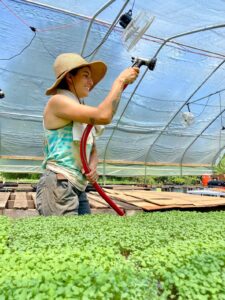
Love is Love Farm grows a variety of organic produce, including leafy greens, tomatoes, okra, strawberries and herbs. They sell to some local restaurants and their 150 CSA (community supported agriculture) members, who pay at the beginning of the season to receive a box of fresh produce every week. As they expand on their new land, they’re planning to increase that to 275 families this spring, as well as grow their wholesale accounts.
The team of five farmers came together through the Working Farms Fund. Joe Reynolds, Judith Winfrey and Demetrius Milling were looking to purchase land through the program and expand their farm; after years of managing other farms, Monica Ponce and her husband, Russell Honderd, were ready to start their own farm on their own land.
But to try to purchase land on their own, “We’d be throwing in every dime we had, and then how would we even buy a tractor, or buy seed, or buy a greenhouse if all of our money was tied up in a down payment?” says Ponce.
Having become friendly over years of crossing paths in the small farming community in greater Atlanta, the group realized they were all in a similar position—ready to scale up, but not sure they had the resources to do it on their own. “Joe has felt for the longest time that to farm in a way not only is organic and sustainable, but also sustainable for the farmer, really takes collaboration with other farmers,” says Ponce. “So we started talking: What would this look like if we all tried to pool our resources together?”
They decided to join the Working Farms Fund together and form a co-op. “We are the workers and we all have equity in the business and collectively own the land,” says Ponce. “We share the risks, we share the rewards and we all share the responsibility.”
The Conservation Fund connected Love is Love with Emory University and the farmers made their first deliveries—sweet potatoes and greens like swiss chard and kale—this winter. Ponce is excited about the massive demand of an institution like Emory—a year-round customer serving thousands of people every day, always asking for more volume. “It’s such an opportunity for farmers in our area to grow into,” she says.
“You drive through Bucks County or Montgomery County or even some of the counties in New Jersey, and you’ll see lots of cornfields on conservation land,” he says. “And that kind of production—commodity grain—is purely extractive, there’s nothing restorative about that practice.”
The team is planning to purchase the land from the Conservation Fund in five years. By that time, they hope to start bringing on new worker-owners. “So, hopefully, as the land becomes a farm in perpetuity, there’s a cycle of farm owners and farm workers that are willing to carry on business, even after we’re retired,” says Ponce. “None of us are inheriting land and none of us are giving land as inheritance to kids, so in a way this is a new version of the small family farm getting passed on.”
In the meantime, they can continue making investments to the property, knowing they’ll reap the benefits in the long-term. For sustainable agriculture, investment in the land—the actual soil—is crucial. Building rich healthy soil takes time and consistent and expensive methods like cover cropping; applying manure; minimizing soil disturbance; and rotating crops.
“Knowing that we’re gonna buy it—it’s gonna be ours—we can continue to build our soil the way we want to,”says Ponce. “Invest in it for the long-term life of the farm.”
Could the Philly area be next?
The model of small to mid-sized farms within proximity to city centers is not new—it’s precisely how we’ve fed our cities in the past. The Conservation Fund did a lot of mapping work as they started this project. “There is still a green belt,” says Funderburke. “You can see it is the historical agriculture that existed around Atlanta where a lot of food was produced.”
Here in Philly, we’ve also got a vast greenbelt around the city—much of which is on the market. According to LandWatch, there are 83 available farms and ranches in Philadelphia County and the seven counties nearest to the city. The most available land is in Montgomery, Chester and Bucks Counties—more than half are fewer than 10 acres in size. About 35 percent of the parcels listed cost more than $1 million.
There are already many organizations working to preserve the farmland outside the city. Part of the Brandywine Conservancy’s work focuses on protecting farmland and helping farmers implement environmentally-restorative land management practices. There’s the Land Trust of Bucks County; the Lancaster Farmland Trust, working to preserve some of the 1,000+ acres of farmland lost to development each year; and many more.
But much of the land in conservation in the greater Philadelphia area is being used for extractive monoculture, says Haile Johnston, co-founder of non-profit regional food distributor The Common Market. The Philly-based company also has locations in Texas and the Southeast, where they’re a partner of the Working Farms Fund. They aggregate food from area farms with a commitment to sustainability and sell mostly wholesale to a wide range of institutions including schools, hospitals, early childcare centers, and restaurants.
“You drive through Bucks County or Montgomery County or even some of the counties in New Jersey, and you’ll see lots of cornfields on conservation land,” he says. “And that kind of production—commodity grain—is purely extractive, there’s nothing restorative about that practice.”
The land is spread with chemical fertilizers; crops are sprayed with pesticides; there’s a lack of biodiversity that provides habitat for diverse insects and pollinators—the base of our ecosystems.
Many landowners, incentivized by agricultural tax breaks, choose to lease to monocrop farmers rather than diverse vegetable and/or animal farmers because the commitment is so much less; the latter requires daily care—and ideally a farmer living onsite—while the former can go weeks or months without any human intervention at all. Which means precious land in close proximity to the city is used for commodity crops often shipped elsewhere for processing rather than food that could be sent straight to greater Philadelphia markets.
These barriers to farmland access for next generation sustainable growers—plus a strong commitment to locally grown food and powerhouse support organizations like Common Market and the Food Trust in the region—could make Philly a good candidate for the Working Farms Fund. It’s those factors the program team looks for when evaluating potential future metro regions, as they’re doing now, says Working Farms Fund Associate Krisztian Varsa.
Johnston thinks it could make a difference in our regional food system, as it has in the greater Atlanta area. “Finding ways to shift the production is important, [as is] finding ways to create equity opportunities for growers,” Johnston says. And tackling both those issues is what makes the Working Farms Fund so unique.
Small to midsize sustainable farms scaling up and selling wholesale in Philly could help nudge along a needed shift for the local food movement—from farmers’ markets in primarily wealthy neighborhoods where it’s sold at often-prohibitive prices, to institutions where it becomes more accessible to all of us.
“When you’re talking about specialty, niche, small-scale—historically that’s meant to the exclusion of many communities,” says Johnston. “The important thing for us is identifying growers who can produce at a scale that allows price points that are more accessible.”
And it’s this system that has the potential to actually feed our cities as climate change makes it harder and harder to grow food—and less feasible to ship it around the world.
“I think we set up this kind of false dichotomy like, You have to be a 10,000 acre farm to feed the world,” says Funderburke. “The reality is—and the pandemic only reinforced this—a more local food system anchored in closer proximity to the city is much safer in times of shocks.”
![]()
RELATED STORIES ON LOCAL FARMING
Header photo: Love is Love Farm Cooperative members, from left, Joe Reynolds, Judith Winfrey, Russell Honderd, Monica Ponce, and Demetrius Milling | By Addison Hill Photography


